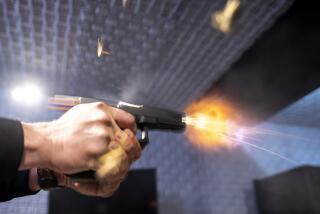Law Enforcement Enters the Space Age
- Share via
Beleaguered cops who are asked these days to solve crimes ranging from terrorist bombings to computer hacking are getting a little more help from some friends: Scientists and engineers across the country are increasingly turning their talents to crime-busting.
The National Aeronautics and Space Administration and several national laboratories are using cutting-edge technology to develop tools to help the cop in the field.
The Energy Department’s Pacific Northwest Laboratory in Richland, Wash., for example, is building a sophisticated vest to be worn by an investigating officer at a crime scene. The vest, called Team Leader, will include all sorts of gadgets that will transmit such things as videos and still pictures and precise measurements of the location of evidence back to headquarters for viewing by other experts.
The Los Angeles County Sheriff’s Department is one of three agencies that will begin testing the vest in about two months.
“It looks intriguing,” said Barry Fisher, director of the department’s crime lab. “It’s an interesting technology.”
As is the case with many of the technologies being developed for law enforcement agencies, the vest is based on previous efforts to deal with a very different set of problems--treaty inspections and other arms-control verification activities.
“The Team Leader system will be kind of an electronic field notebook,” said Dan Irwin, a research analyst and project manager at the Pacific Northwest Laboratory.
Although still under development, it will feature a video camera on a helmet, a computer strapped to a belt and a vest loaded with gizmos ranging from a global-positioning-system receiver to an instrument that will put a bar code on a piece of evidence. The bar code will allow tracking of the evidence, showing who has seen it and who still needs to see it.
The vest will also include a laser range finder that will make measurements to an accuracy of about a quarter of an inch. That will replace the tape measure and provide a more exact record of the location of evidence, a factor that could be crucial in a criminal trial.
The lab is teaming up with Mnemonic Systems Inc. of Washington to develop the vest. By using off-the-shelf equipment and standard software to hold down the cost, the lab hopes to keep the price tag at about $10,000.
To succeed, Irwin said, the system must be easy to use, easy to put on and not restrain the officer.
“If we’ve got a system that’s awkward, nobody’s going to use it,” he said.
He admits it has been a learning process. Originally, the lab had designed a system that included a keyboard on the officer’s wrist.
“When you’re sitting here in the laboratory, that looks really cool,” he said. “But the user community came back and said, ‘We don’t really know how to type all that well, and the keys are too small, and we may have a glove on, and there could be blood on the glove. . . .’ ”
The result: a larger, more usable keyboard.
The lab is compromising slightly on the vest’s communications range. The energy needed to transmit the images and data to an office several miles away would require the use of heavy batteries. So the vest will transmit the information to a nearby van, which will relay it back to headquarters.
“Nobody is going to want a vest that weighs an extra 8 pounds because of the battery needed to transmit back to headquarters,” Irwin said.
In another potential bonanza for law enforcement, NASA recently entered into an agreement with the National Institute of Justice, the research and development branch of the Justice Department, to see if gadgets that have been used to explore other planets might also be used to find crooks.
Jeff Schweitzer, a nuclear astrophysicist at NASA’s Goddard Space Flight Center, helped set up the joint program. The aim is to develop tools that can be used at the scene of a crime for subsequent analysis back in the lab.
“These would be small and compact and totally self-powered,” he said. One example: a heat-protected robot similar to the Mars Sojourner that could carry instruments into an arson scene before it has cooled and much of the evidence--such as chemicals used to start the fire--has vanished.
X-ray machines such as those used aboard several space probes could instantly identify chemicals present at a crime scene, Schweitzer said. They could also find tiny metal fragments from a weapon that had been fired, thus providing a “fingerprint” of the weapon.
But if it turns out that the weapon is an unexploded bomb, Los Alamos National Laboratory--the New Mexico lab where the biggest bomb of all was designed--may have just the thing needed to capture the bomb without endangering nearby people or destroying the evidence.
Working with New Mexico state police, the lab is developing a portable container that can capture shrapnel from a pipe bomb and direct the blast away from humans.
Called the “frag bag,” the container will be light enough to be carried by an officer, and it will contain no metal, so X-ray machines will be able to peek inside.
The lab is also developing a similar device that will contain an explosion, thus preserving the chemicals and fragments that could be vital in a trial.
Some of these projects, of course, will turn out to be more useful than others, and all of them are likely to undergo some changes after extensive testing in the field.
“We can’t come up with a perfect system in the laboratory,” said Irwin of the Pacific Northwest Laboratory. What he will need is a lot of advice from cops on the beat.
There’s no doubt about one thing: He will get it.
*
Lee Dye can be reached via e-mail at leedye@compuserve.com.






